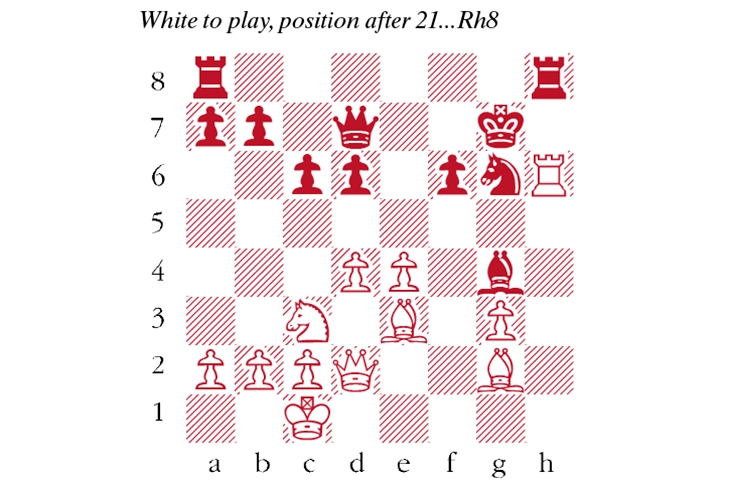Does Bear Grylls play chess? If he does, I’m sure he would favour the King’s Gambit. As chess openings go, it is primitive and hazardous. Playing it well demands a kind of reckless, wholehearted optimism that few can muster. Ostensibly, you sacrifice just a pawn (1 e4 e5 2 f4), but really, you’re already in deeper, since the aspiring gambiteer mustn’t flinch from chucking a piece or more on the bonfire. Most players find it more agreeable to watch others sacrifice their pieces.
Indeed, sacrificial classics such as the ‘Immortal Game’ (Anderssen–Kieseritzky, London 1851) have a timeless appeal. But for those with the requisite swagger, nothing stokes the imagination like playing the opening. It remains promising in the modern era — provided the opponent is not expecting it.
This game was played in the Legends of Chess tournament, the fourth event in the Magnus Carlsen Chess Tour. Once ranked second in the world, the Ukrainian Vasyl Ivanchuk, now 51 years old, continues to delight fans with his inventive play and otherworldly demeanour. You never know what to expect from ‘Chucky’, who is as adept with a cosy Catalan opening as with the open flame of a King’s Gambit.
His universal style is nicely illustrated by the nonchalant 22 b3!, perhaps the deepest move of the game. Coming right after the exchange sacrifice 18 Rxh6, it looks tempting to seek immediate dividends on the kingside. Instead, Ivanchuk signals a change of pace — tucking away his king, and regrouping the minor pieces. The breakthrough comes a few moves later, and despite having an extra rook for three pawns, Leko’s position crumbles.
Vasyl Ivanchuk–Peter Leko
Legends of Chess, July 2020
1 e4 e5 2 f4 exf4 3 Nf3 h6 4 d4 g5 5 g3 fxg3 6 hxg3 Bg7 7 Nc3 d6 8 Be3 Nf6 9 Qd2 Ng4 10 Bg1 Nc6 11 O-O-O O-O 12 Nh2 Nxh2 13 Rxh2 Bg4 14 Re1 Ne7 15 Bg2 This looks slow, but Ivanchuk’s kingside buildup proves surprisingly hard to meet. Qd7 16 Be3 Ng6 17 Reh1 c6 18 Rxh6 Bxh6 19 Rxh6 Kg7 20 Bxg5 f6 21 Be3 Rh8 (see diagram) 22 b3! What composure! Rxh6 23 Bxh6+ Kh7 24 Bf1 Bh3 25 Be2 Re8 26 Kb2 b5 27 Bd3 Qg4 28 Be3 In fact, 28 e5! was already strong. b4 28…Qxg3 29 e5! was probably Ivanchuk’s idea, e.g. 29…dxe5 30 Ne4 Qf3 31 Bg5 Re6 32 Bxf6! with attack. 29 Nd1 Qxg3 30 Qxb4 Bg4 31 e5! f5 31… Bxd1 32 Qb7+ Kh8 (32…Kg8 33 exf6!) 33 Qxc6 hits the rook and threatens a fork on h1. 32 Qxd6 Bxd1 33 Bxf5 Rg8 34 Bd2 Bg4? Losing, but Black was in serious trouble anyway. It is hard to meet Qd6-f6 followed by e5-e6-e7, and so on. 35 Qe7+! Rg7 36 Qg5 A lovely double pin, netting a piece. Qh2 37 Bxg4 Ne7 38 Qh5+ Qxh5 39 Bxh5 The bishops and pawns are too strong and the rest is easy for Ivanchuk. Rg2 40 Bb4 Nd5 41 Bf3 Rf2 42 Bxd5 cxd5 43 Bc5 a6 44 b4 Kg6 45 a4 Kf5 46 b5 axb5 47 axb5 Ke6 48 b6 Kd7 49 Kb3 Kc6 50 c4 dxc4+ 51 Kxc4 Rf4 52 e6 Re4 53 e7 Kd7 54 b7 Kc7 55 Bd6+ Kxb7 56 Be5 Black resigns
Winning with the King’s Gambit commands respect like nothing else. On learning that Ivanchuk had dared, and won, Magnus Carlsen exclaimed ‘That’s awesome… That’s my boy!’ Carlsen was the eventual winner of the event, beating Ian Nepomniachtchi in the final.






Comments